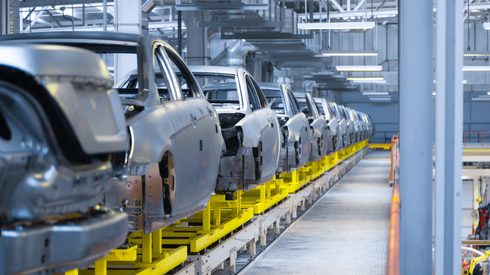High stainless steel production in China in 2023 generated lofty imports of raw materials, including chrome ore, ferro-chrome, nickel pig iron (NPI) and ferro-nickel.
Stainless steel output
China produced 26.61 million tonnes of crude stainless steel in the first nine months of 2023, up by 11.93% from 23.81 million tonnes in the corresponding period of 2022, according to data published by the China Stainless Steel Council (CSSC).
During that period, type-300 stainless steel output totaled 13.56 million tonnes, a 13.99% year-on-year increase from 11.89 million tonnes, the CSSC said.
“The annual crude stainless steel output could be 35-36 million tonnes in 2023, while CSSC reported that 2022’s output was 31.98 million tonnes. The type-300 stainless steel output would be around 18 million tonnes in 2023, compared with CSSC’s data of 16.68 million tonnes in 2022,” one industry analyst told Fastmarkets.
Chrome ore imports
China’s chrome ore imports broke a new record in 2023, with the increased appetite feeding the high production capacity utilization rates of ferro-chrome, according to sources.
“The more stainless steel we produce, the more ferro-chrome we need and the more chrome ore we need,” one Chinese smelter source said.
Chrome ore is smelted into ferro-chrome, which is mostly used in the production of anti-oxidation and corrosion-resistant stainless steel.
China is highly dependent on imported chrome ore due to the lack of domestic resources for the material.
The country imported just short of 2 million tonnes of chrome ore in December, up 10% month on month and up 52% year on year, according to data released by Customs of China on Monday January 22.
December’s monthly import total was a record high, breaking the former record of 1.81 million tonnes of chrome ore set in November 2023.
“Traditionally, monthly imports of chrome ore are 1.2 million tonnes,” one Chinese chrome ore importer source told Fastmarkets. “However, the imports in several months of 2023 were higher than 1.5 million tonnes and this level has become normal now.”
Total Chinese chrome ore imports for 2023 were 18.33 million tonnes, up 22% from 2022. The top three suppliers during the year were South Africa, Turkey and Zimbabwe, with shares of 81%, 6% and 4% respectively.
Ferro-chrome imports
China still needs to source ferro-chrome from seaborne markets because its domestic production of alloy is not sufficient to satisfy the demand of stainless steel in the country.
Ferro-chrome imports to China were 3.25 million tonnes in 2023, an increase of 36% over 2022’s 2.28 million tonnes, according to Customs data.
The top three origins during the year were South Africa, Kazakhstan and India, with shares of 58%, 22% and 11% respectively.
Ferro-chrome imports hit a record monthly high of 412,115 tonnes in April 2023.
But with the higher production of ferro-chrome in China, it will be difficult to sustain these high levels of imported material or even to widen the market share, according to sources.
China’s NPI import at all-time high in 2023
China’s high stainless steel production also caused import volumes of NPI and ferro-nickel to reach all-time highs in 2023, China’s official customs data showed.
The country imported 8.45 million tonnes of NPI and ferro-nickel in 2023, a 42.95% jump compared with 5.91 million tonnes in 2022.
“Though stainless steel demand was not great [last year] and prices were overall on a downtrend, [stainless steel] mills still maintained high production rates,” a NPI trader based in eastern China said. “So demand for raw material NPI was generally good in 2023.”
Indonesia, the dominant supplier of China’s NPI, suspended the issuance of nickel ore mining quotas in August, sparking supply concerns and intense buying of NPI from the nickel-rich country.
The panic buying pushed the volume of NPI and ferro-nickel imported into China to the highest level in a single month in August at 910,456 tonnes. Of this total, 865,701 tonnes, or 95.08%, were from Indonesia.
China imported 7.93 million tonnes of NPI from Indonesia in 2023, accounting for 93.81% of China’s total NPI and ferro-nickel imports.
Despite the high demand and intense buying, NPI was still under mounting pressure from a huge supply surplus in 2023, leading to a deep dive in prices throughout the year.
Meanwhile, the downtrend in stainless steel prices, which squeezed stainless steel mills’ profit margins, also took its toll on the NPI market.
“It’s just a common practice for stainless steel mills to bid lower for raw materials to get themselves some profit margins,” a second NPI trader based in eastern China told Fastmarkets.
“Especially in an oversupplied market such as NPI, when sellers have to fight a price war with each other to compete for demand,” the second trader added.
Fastmarkets’ weekly price assessment of nickel pig iron, high-grade NPI content 10-15%, spot, ddp China was 925-940 yuan ($130-132) per nickel unit on December 29, the last pricing day of 2023. This was a 32.43% drop from 1,370-1,390 yuan per nickel unit on January 6, 2023 – the first pricing session of the year.
The daily assessment for nickel pig iron, 10-14% Ni content, fob Indonesia was at $112-114 per nickel unit on Tuesday January 11, a 13.74% drop from its peak at $130-132 per nickel unit when the assessment was launched by Fastmarkets on October 27.
Navigate the complex steel markets with our reliable and market-reflective steel price data and transparent pricing methodology. Also, don’t miss the chance to connect with Asia’s most influential decision-makers from across the ferroalloys supply chain in Hong Kong at Fastmarkets Ferroalloys Asian Conference 2024 on February 26-28.





